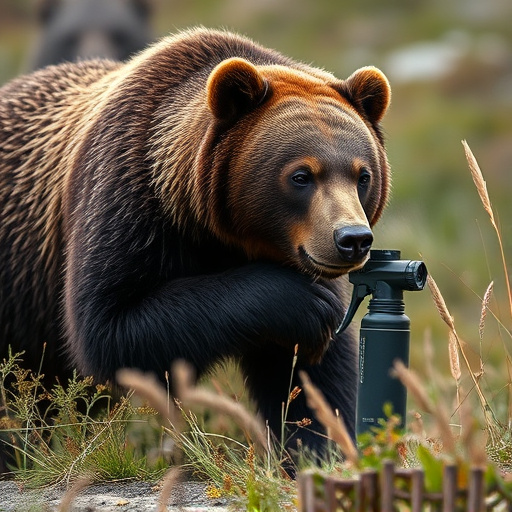Bear pepper spray, composed of capsaicin, deters aggressive bears by irritating sensory systems. TSA restricts it in carry-ons but allows checked baggage with 7 oz or less containers. Choose robust cans meeting industry standards, understand application techniques, and adhere to destination regulations for optimal protection and safe travel.
In bear country, having the right defense can mean the difference between safety and tragedy. Bear pepper spray has emerged as a powerful tool, offering maximum stopping power against aggressive bears. This comprehensive guide explores the science behind bear spray composition and its effectiveness, delving into TSA regulations on travel-sized sprays and essential choices for optimal protection. Learn proper use techniques and discover inspiring real-world success stories.
- Understanding Bear Spray Composition and Effectiveness
- TSA Regulations on Pepper Spray in Travel
- Choosing the Right Bear Spray for Maximum Protection
- Proper Use and Application Techniques for Optimal Defense
- Real-World Scenarios: Bear Spray Success Stories
Understanding Bear Spray Composition and Effectiveness
Bear spray, also known as bear pepper spray, is a specialized defense mechanism designed to deter aggressive bears. Understanding its composition and effectiveness is crucial when considering it as a bear attack deterrent. The primary active ingredient in bear spray is capsaicin, derived from chili peppers. This substance irritates the bear’s eyes, nose, and respiratory system, temporarily disabling it and providing the user with an escape route.
The effectiveness of bear spray lies in its ability to create a safe distance between the user and the bear. When sprayed correctly, it can stop an attacking bear in its tracks, giving users valuable time to retreat or seek shelter. However, factors like weather conditions, distance, and the bear’s behavior can impact its performance. Additionally, the TSA (Transportation Security Administration) has specific restrictions on bear pepper spray due to its potential as a weapon, limiting its carriage on flights. Therefore, knowing local regulations and understanding the spray’s limitations is essential for anyone venturing into bear country.
TSA Regulations on Pepper Spray in Travel
When packing for travel, especially outdoor adventures, it’s crucial to understand the Transportation Security Administration (TSA) regulations on bear pepper spray. While bear pepper spray is a valuable defense tool, it must comply with strict guidelines to ensure safety and security during air travel. The TSA permits the carrying of bear pepper spray in checked baggage, but there are specific restrictions regarding its size and contents. Typically, containers should be 7 ounces or less, and they must be clearly labeled as pepper spray.
These regulations are in place to maintain order and prevent misuse. Passengers are not allowed to carry bear pepper spray as a liquid in carry-on bags due to security concerns. The TSA categorizes it as a hazardous material, which necessitates careful handling during the flight. By adhering to these restrictions, travelers can ensure their safety while also respecting aviation safety protocols.
Choosing the Right Bear Spray for Maximum Protection
When selecting bear spray for maximum protection, it’s crucial to consider factors beyond just potency. Choose a brand that meets or exceeds industry standards for effectiveness against both black and grizzly bears. Look for a can with a strong construction that ensures consistent performance in various weather conditions.
Additionally, be mindful of TSA restrictions on liquids, especially if you plan to travel with your bear spray. Bear pepper spray is typically allowed, but quantities are limited. Check the specific regulations for your destination to ensure compliance and avoid any inconvenience during your journey.
Proper Use and Application Techniques for Optimal Defense
Proper use and application techniques are crucial for optimal defense with bear pepper spray. To ensure maximum stopping power, users must understand the recommended range and timing for deployment. Typically, bear pepper spray should be aimed at the bear’s face and eyes, within a distance of 2-3 meters (6-10 feet). A quick, short burst of 2-3 seconds is usually sufficient to cause temporary disorientation and retreat. However, it’s important to remember that direct contact and prolonged exposure are not necessary for effectiveness; aiming accurately and applying the spray correctly is key.
Additionally, understanding TSA restrictions on bear pepper spray is essential for travelers. The Transportation Security Administration (TSA) allows bears spray in checked baggage but has strict guidelines on size and quantity. Only containers of 3.4 ounces or less are permitted, and they must be packed separately from food and other items to avoid contamination. Bear pepper spray should also be labeled clearly to pass through security without incident. Following these guidelines ensures that individuals can travel with the protection of bear spray while adhering to safety protocols.
Real-World Scenarios: Bear Spray Success Stories
In real-world scenarios, bear spray has proven to be an effective defense mechanism against aggressive bears. Many hikers and outdoor enthusiasts have shared stories of close encounters where they were able to safely deter a charging bear using bear pepper spray. These success stories highlight the importance of carrying bear spray as a last line of defense when encountering dangerous wildlife.
For instance, in regions with strict TSA restrictions on liquids, bear pepper spray is often allowed in carry-on luggage due to its classification as an aerosol. This accessibility ensures that hikers and campers have quick access to a powerful deterrent during unexpected encounters. Bear spray has been particularly useful in areas known for frequent bear activity, where it serves as a crucial tool for personal safety and peace of mind.
Bear spray, also known as bear pepper spray, has proven itself as a powerful defense mechanism against aggressive bears. Understanding its composition and effectiveness is crucial for choosing the right product that complies with TSA restrictions on pepper spray in travel. By selecting the appropriate bear spray and mastering proper use techniques, individuals can enhance their safety in potential encounters while navigating through diverse landscapes. Real-world success stories underscore the significance of carrying bear pepper spray as a vital component of outdoor preparedness.
